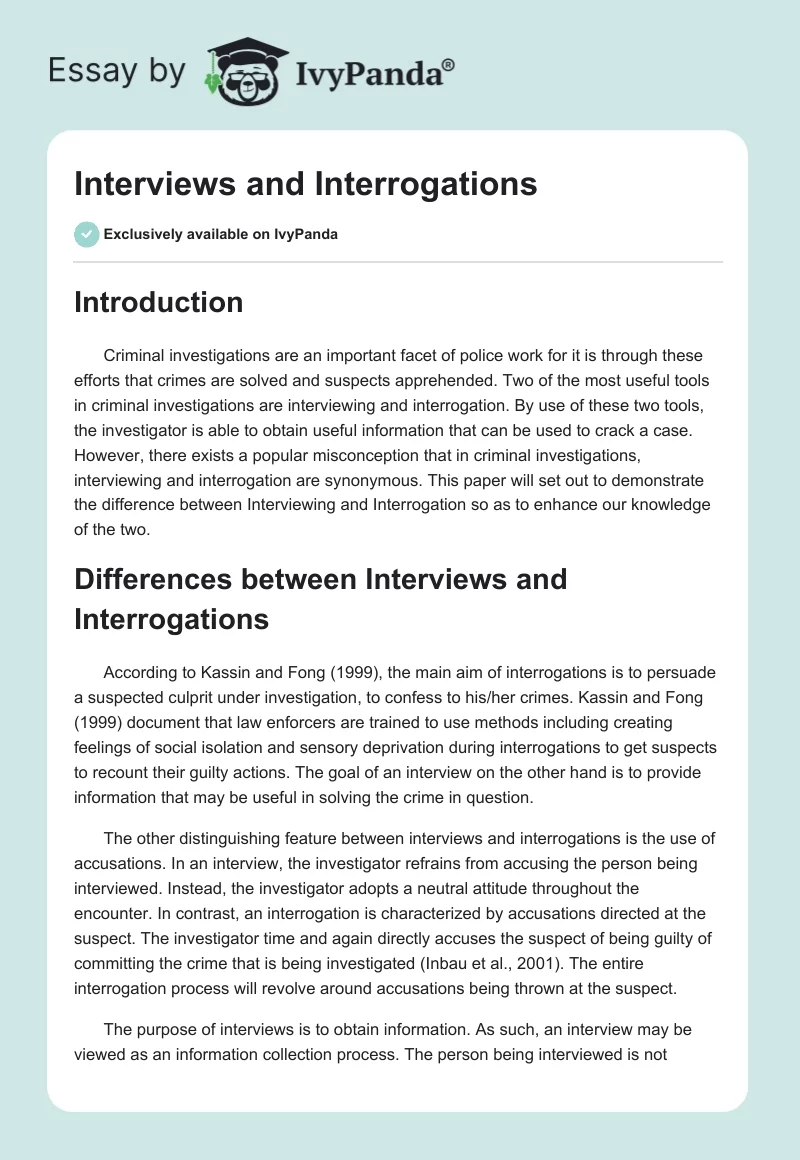Introduction
Criminal investigations are an important facet of police work for it is through these efforts that crimes are solved and suspects apprehended. Two of the most useful tools in criminal investigations are interviewing and interrogation. By use of these two tools, the investigator is able to obtain useful information that can be used to crack a case. However, there exists a popular misconception that in criminal investigations, interviewing and interrogation are synonymous. This paper will set out to demonstrate the difference between Interviewing and Interrogation so as to enhance our knowledge of the two.
Differences between Interviews and Interrogations
According to Kassin and Fong (1999), the main aim of interrogations is to persuade a suspected culprit under investigation, to confess to his/her crimes. Kassin and Fong (1999) document that law enforcers are trained to use methods including creating feelings of social isolation and sensory deprivation during interrogations to get suspects to recount their guilty actions. The goal of an interview on the other hand is to provide information that may be useful in solving the crime in question.
The other distinguishing feature between interviews and interrogations is the use of accusations. In an interview, the investigator refrains from accusing the person being interviewed. Instead, the investigator adopts a neutral attitude throughout the encounter. In contrast, an interrogation is characterized by accusations directed at the suspect. The investigator time and again directly accuses the suspect of being guilty of committing the crime that is being investigated (Inbau et al., 2001). The entire interrogation process will revolve around accusations being thrown at the suspect.
The purpose of interviews is to obtain information. As such, an interview may be viewed as an information collection process. The person being interviewed is not suspected of the crime but he/she is deemed to have information that may be of use to the investigation. On the other hand, Inbau et al. (2001) state that the purpose of interrogation with regard to information is to test the validity of the information that has already been obtained through other means. An interrogation, therefore, recreates by use of available information and what is discovered in the process is documented.
The relationship between the investigator and the subject also greatly varies based on whether a person is being interviewed or being interrogated. In an interview, there is a spirit of cooperation and the relationship is more collaborative. This is mainly because creating a cooperative mood and environment helps the investigator to reach better conclusions regarding the case and the involvement of the subject in the case being investigated. Interrogation on the other hand is adversarial in nature and the relationship between the interrogator and the suspect is mostly hostile. Creating these environments forces the subject to confess his/her crimes so as to clear his/her conscience or get a lenient punishment for crimes done. From this, it can be said that interrogation is confrontational in nature while interviews are not.
In addition, Blair (1999) asserts that interviews are a more flexible and less demanding form of interaction held between the investigator and the subject. In other words, the author states that an interview can be viewed as a dialogue through which each party can ask questions and get answers accordingly. On the other hand, interrogations are more intense and require a high level of persuasion from the interrogator. As such, in an interrogation, the investigator often dominates the conversation making it seem like a persuasive monologue rather than the conventional dialogue.
On the same note, Blair (1999) states that during an investigation, an interview can be conducted at any time so as to gain more insight (information) regarding the case at hand. In addition, interviews often last for an hour or less and require minimal planning and preparations. In contrast, interrogations are conducted only when the investigator has reasonable evidence indicating that the suspect is guilty. Similarly, interrogations often last for more than an hour (even days) and require extensive preparations as well as planning. As mentioned earlier, the purpose of the interviews is often to gather the information that may be useful to a case. As such, it interviews are often general and informal dialogues. On the other hand, interrogations aim at getting a confession after a subject has shown signs of guilt regarding the case at hand.
Conclusion
Interviews and interrogations have proven to be valuable tools in the search for justice and safeguarding the innocent. However, it is imperative that the investigator understand the difference between these two tactics as well as their purpose. In this essay, key differences have been highlighted all the while describing the purpose of these tools. However, Inbau et al (2001) state that interrogations should only be used when other forms of getting information have failed. The authors recommend that non-accusatory interviews can go a long way in establishing the truth all the while ensuring that people are not falsely accused. In so doing, the truth will always prevail and the guilty will be kept at bay.
References
Blair, J. interview or interrogation. Web.
Inbau F. E., Reid, J. E., Buckley, J. P., & Jayne, B. P. (2001). Criminal Interrogations and Confessions. Gaithersburg, MD: Aspen.
Kassin, S. M. & Fong, C. T. (1999). “I’m Innocent!”: Effect of Training on Judgments of Truth and Deception in the Interrogation Room. Law and Human Behavior, 23(5).


